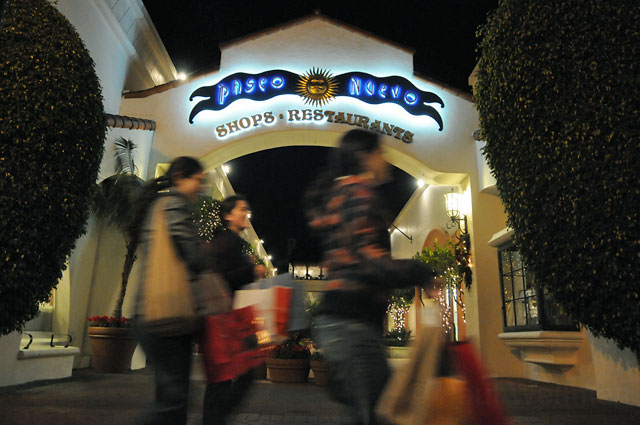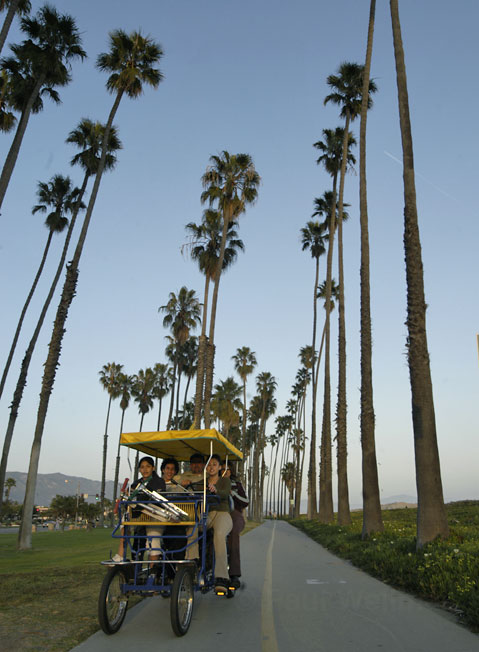Visitor Bookings Looking Better and Better
Tourism Industry Experts Predict Improving Numbers Will Hold, Continue to Climb

“I’m tempted to break out vodka with the orange juice,” joked Kathy Janega-Dykes, president and chief executive officer of Santa Barbara County’s Conference and Visitors Bureau, during this year’s tourism outlook summit.
Addressing a crowd of more than 100 hoteliers and business owners at the DoubleTree Resort last Thursday morning, Janega-Dykes and industry experts explained how robust area visitor traffic is these days compared to the months of free-falling occupancy rates and dwindling consumer confidence figures that plagued 2009 and early 2010.
Speakers predicted that conditions will continue to improve throughout 2011 — reports indicate there was already an upswing during the last few months of this year — as the economy recovers and people feel less guilty about spending money on traveling.
While it “may take a while for things to get back to the way they were,” Janega-Dykes remarked, “at least the needle is pointing in the right direction.” An October report, for example, showed that the City of Santa Barbara’s lodging occupancy rate stands at 72.3 percent. That’s 4 percent higher than 2009’s rate but still 2 percentage points below 2008’s. The county’s rate as a whole has jumped 3 points since 2009, averaging out at 66.4 percent according to reports released last month.
During his annual “Santa Barbara County Lodging Forecast,” Bruce Baltin of Colliers PKF Consulting said he predicts the occupancy rate to jump to 67.2 percent by the end of the year and reach 69.5 percent by the close of 2011. Our forecasted rates, he explained, are just behind those of Los Angles, Orange, and San Diego counties, which isn’t unusual. “You’re holding your own,” Baltin comforted.

Baltin said recent renovations at several area hotels and motels helped stem what was a tide of worrisome vacancies, but stated there are still “high barriers to new hotel development.” There aren’t many new lodging locations set for construction, he went on, “although Caruso’s Miramar Project remains active and El Encanto is slowly moving toward reopening.” Within the next six years, Baltin also noted, two Goleta hotels will be built — with one near UCSB — if everything goes as planned.
Baltin claimed it’s possible for the county to boost its occupancy rate, but that means continuing to renovate properties and look for areas of improvement. Booking convention and conference spaces during the off season is a must, he explained.
Dan Mishell with the California Travel and Tourism Commission offered numbers on current and future statewide trends. He explained that in 2009 there were 36 million trips taken to California for leisure purposes, and that $24 billion was spent during those vacations. People traveling from six states — Washington, Oregon, Nevada, Utah, Colorado, and Arizona — account for nearly half of California’s visitors and one-third of nonresident spending in the state, he said.
Internationally, Mishell went on, Canada, the U.K., and Japan supply the most visitors and revenue to the Golden State each year, with 2009 as no exception. And south coast counties, he summed up, contain nearly half of California’s entire lodging inventory.
Looking ahead, Mishell noted that consumer confidence has stabilized (his accompanying Powerpoint slide showed a near-vertical, downward-trending line between 2007-2008) but at a notably low level. One in four Americans are now spending less, staying with friends and relatives, and driving instead of flying, he said.
Nevertheless, he continued, total visits to the state will have increased 4 percent by the end of 2010 compared to 2009, and will jump up another 3.1 percent in 2011. Spending will have gone up 7.4 percent by the end of 2010, and will increase 5.6 percent in 2011. While the state’s tourism industry has recovered better to date than expected, Mishell predicts numbers will show that visits during the last few months of 2010 and heading into 2011 began to slow down. A full report can be viewed here.
Shifting away from figures, Mishell also touched on a few emerging consumer trends. “Recovery consumers,” as he called them, “are redefining value in a new era of consequences.” They want transparency, trustworthiness, and authenticity, he said, and consumers’ definition of “luxury” is changing as they “want meaning along with material goods.”
Tom Skelton of TripAdvisor — which was founded in 2000 and recently became the country’s top travel Web site by surpassing 40 million unique visitors in one month — spoke to the crowd about the importance of digital word-of-mouth. Noting that his company is completely transparent because it reportedly doesn’t edit or filter any of its user-provided content (firsthand reviews and reports), Skelton said TripAdvisor allows users to tap into their collective knowledge and use that information to map out their perfect vacation or business trip.
“Online information via Web sites is the predominant source of travel information for U.S. travelers,” said Skelton, claiming that around 55 percent of people use the Web as their go-to resource for trip planning.
Based on September 2010 TripAdvisor traffic logs, users checked out Santa Barbara around 500,000 times, good for a ranking of ninth out of the 13 California cities most visited through the site. Outside of the U.S., the cities and countries doing the most research on Santa Barbara and its offerings are, in descending order: London, England; Madrid, Spain; Sao Paolo, Brazil; Montreal, Quebec; and Manchester, England.
According to a survey of more than 3,000 travelers, Skelton said, 36 percent of them expect to spend more on leisure travel in 2011 than they did in 2010. A full 90 percent said they plan to take two or more leisure trips next year — a slight increase on the 89 percent who said they had done so in 2010.
Skelton also talked about what people considered the “best” and “worst” tourism trends in the coming year. Travelers are excited about more online deals, cheaper hotel rates, and more Wi-Fi access on planes. They’re less enthused, however, about carry-on baggage fees, new hotel fees, and TSA full-body scanners.
Lastly, Skelton conveyed the top vacation activities for next year. They are, in descending order: visiting an historic site, going to a museum, traveling to a national park, attending a festival, hiking, taking part in water activities, visiting a spa, and gambling. Nearly 50 percent of those surveyed said they would take eco-friendly factors into consideration before and during their time on the road.



